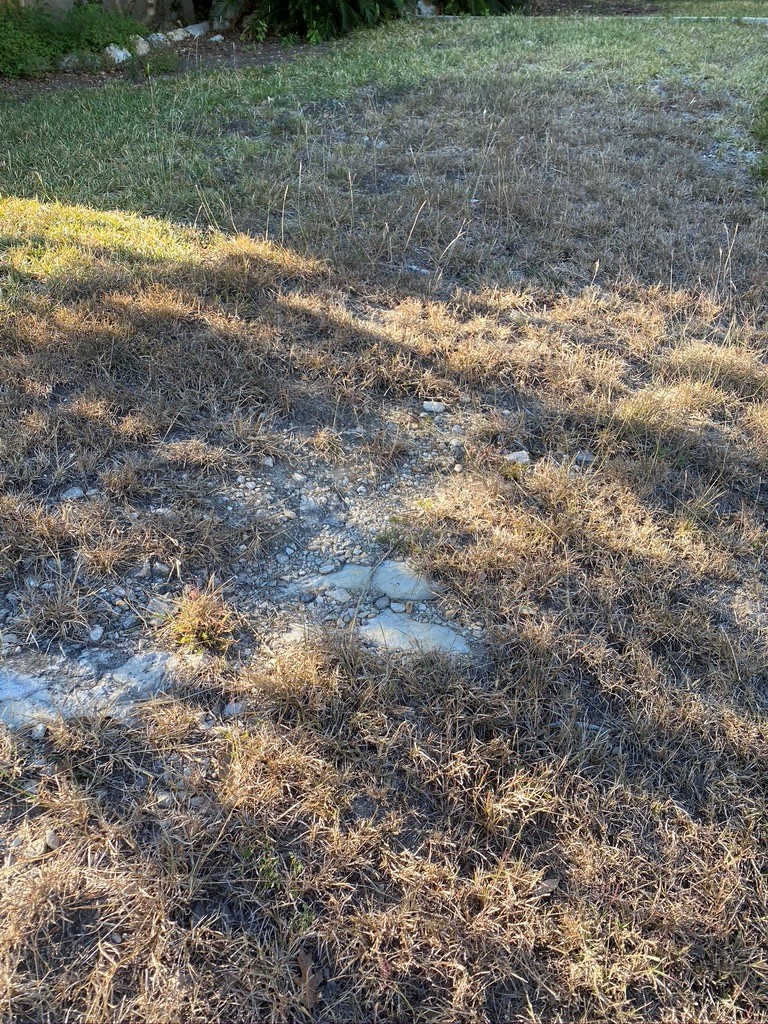by Bill Swantner, Bexar County Master Gardener
There must be a dozen types of grasses grown as “lawn grass” in the state of Texas – but Texas is a big state. Along the coast of Texas, the turfgrass must be able to grow in sandy soil with a high salt content; in far west Texas the temperatures can be blistering hot in the daytime yet cool at night. The lows in the panhandle can reach single digits, east Texas has an acidic soil, and our area has a predominantly high alkaline-clay content. Add to that, there are warm weather grasses and cool weather grasses. I’m growing over 13 varieties of lawn grass in demonstration containers. As I’ve listened to David Rodriguez on his Saturday morning gardening show on WOAI, it seems the two biggest issues we have with our turfgrass are: soil and selection.

Soil
Turfgrass needs 6 inches of good soil to develop roots that can absorb adequate nutrients and water. In far north Bexar County, from around Bandera and Loop 1604 over to I-35 and 1604, the native soil is very thin, maybe two to four inches. The largest swath of Bexar County is a thick “gumbo” clay soil. In southwestern Bexar county, the soil is a mixture of sand & clay, and in south Bexar County in the I-37 and Sandy Oaks Olive Orchard area, the soil is similar to white beach sand. Each of these soils has its own special challenges. In newer homes, the soil may be full of rocks and leftover concrete and lumber. Sometimes the topsoil is little more than caliche. The “fix” is adding compost and/or a lawn dressing mixed with compost. As David Rodriguez has mentioned, many “lawn dressings” have a large amount of sand in it, so he suggests adding additional compost. It might take a few years, and the lawn area might need to be reconsidered (maybe use mulch or a ground cover instead of turfgrass), but a healthy turfgrass needs 6 inches of good, rich soil.

Another issue with soil is compaction. People walk on their turfgrass, children play on it, dogs make trails, some people park their vehicles on it, and just the force of gravity causes soil to compact. Good soil allows for the free flow of water and air through the sand, silt, clay, and organic materials. Compaction stops the flow of water and air and makes it difficult for turfgrass to grow a healthy root system. Weeds seem to have an easier time growing in compact soils! The remedy for soil compaction is soil aeration and/or compost. Aeration puts holes in the soil so compost, water, or fertilizer can reach deeper into the soil. Compost works with soils to either break up clay soils or form aggregates in sandier soils.
Selection
Sunlight
All turfgrass needs some degree of either direct sunlight or lightly filtered light. Palmetto and FJ Select are the most shade tolerant varieties of St. Augustine grass. Buffalo and Bermuda grasses do not tolerate any shade. Bermudagrass is used in many new lawns, planted right up to Live Oak trees. In time, the Live Oak will start shading out the Bermuda grass—causing it to die back. While turf grasses might “grow” in shade, it is more susceptible to insects and disease.

Foot traffic
St. Augustine grasses do not tolerate, “foot traffic” because it has stolons. Stolons are creeping horizontal plant stems that take root at points along its length to form new plants. With stolons growing on top of the soil, the pressure of foot traffic damages the vascular system of St. Augustine. Bermuda, Buffalo, and Zoysia have rhizomes (modified stems) growing underground and are more tolerant of people and pets…not so much cars and trucks.
Water
St. Augustine requires the most water, Buffalo the least, with Bermuda and Zoysia somewhere in between.
Each turfgrass has its advantages and disadvantages, insect and disease weaknesses, watering, fertilizing, and general care requirements. For further reading, here are some links:
Buffalo grass: https://aggie-horticulture.tamu.edu/plantanswers/turf/publications/buffalo.html
Bermuda grass: https://aggieturf.tamu.edu/texas-turfgrasses/bermudagrass/
St. Augustine grass: https://aggieturf.tamu.edu/texas-turfgrasses/st-augustinegrass/
Zoysia: https://aggieturf.tamu.edu/texas-turfgrasses/zoysiagrass/
All photos courtesy of Bill Swantner, BCMG.
